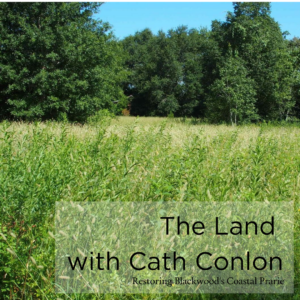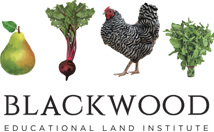
For more than 20 years, Cath Conlon has been stewarding the land at Blackwood Educational Land Institute. Without her vision, we’d be nowhere. To celebrate her passion and success, and show the world how we plan to keep moving forward, we’re starting a series about Cath’s vision and what she’s up to on The Land.
Right now, Cath is focused on restoring the Coastal Prairie Ecosystem on Blackwood’s property.
What’s the impetus to restore the prairie? What effects does it have on the land and on the crops you’re growing?
We need biodiversity. Diversification is what draws insects and birds to us, which helps with pollination. Have you heard about “edges?”
No.
If you’re hiking, as long as you’re walking on the trail, the places where the sun comes through will have lots of growth on the edges. When you go into the forest, though, you’ll notice not a lot of growth. The edge inside the forest is on the top. The edge is where all the activity of life takes place.
I always thought I wanted Blackwood to be huge. And then, when I learned more about edges, I changed my mind. If we’re huge, the inside will be dead! We want to be small so everything is active and so we don’t have any dead spots.
My new phrase is “You cannot take nature out of farming.” That just makes everything more rich — when you realize when you farm you can’t take nature away. You can look at the whole of life through farming.
Is the coastal prairie a dead spot right now?
No. It was losing its diversity and we weren’t doing anything to preserve it. Am I purist? In many ways, no, but in the health of a spot, I think purity is important. Texas is so patchy with ecosystems and we just like to preserve it. Number one, because of diversity, and number two, because we want people to know what they’re looking at on our land and know how to do it on their own.
What is the first step to restore the prairie?
There’s rye grain in the prairie area, and I’m the one who put it out there. I wanted to know if we could grow grains in our garden. The grain isn’t everywhere; there’s a lot on the edge, but not relative to the rest of the field. I’m hopeful we can successfully get rid of the ryegrass.
What is your favorite option for getting rid of the ryegrass?
I want to try zonation first. Zonation is when you add clear plastic on top of the area you want to remove the unwanted plants from. You find the hottest day of the year, and put the plastic on a week before and a week after. I’ll also use a natural herbicide, which is a combination of agricultural vinegar, orange oil and liquid dish soap.
How big of an area is the ryegrass area?
Probably a 50’x50’ area. But it’ll take years—four to five years—to control the ryegrass because it’s dropped seed. We’ll buy little and big bluestem—those are two plants the field is missing—and we’ll use a seed drill to put them into the soil.
Are you looking for grants to use your own seed drill?
There are only two people who know how to use a seed drill in the Houston area. I thought if we are going to be an educational site, we should teach people how to use the seed drill to restore their own area.
Are you planning on burning or mowing the prairie?
I think we’ll burn it in a couple of years. Fire is “prescribed” every 1-3 years. You want a lot of tall grasses in the area for a less patchy burn.
I can’t believe some people are saying they approach their prairie jobs using herbicides and excessive burning to move more quickly. People want instant results. We don’t. We are fostering it in a quick way, but we think the timeline is longer.
You’re talking to Katy Prairie Conservancy about this project. Is that because if their prairie thrives Blackwood’s thrives?
Yes. And it’s awareness. I imagine at some time Houston will be around Blackwood, so we need to preserve as much as we can so there’s farmland and more wild buffers in the city.
Why is it important for you to get this information to the community?
You can’t take the Land Institute’s book or Bill Mollison’s book and directly interpret it. You gather all the information you can and see what you can do your best for in your spot. We want to be some of the people providing information on just how to do this.
We want to be a teaching farm, not somebody who says you have to do everything this or that way. We need to encourage people to experiment. That’s why we’re being open about what we’re doing on our land.
Are you laying out a plan to do this?
Yes, we have a plan. But also, we don’t know all the answers, and even acclaimed scientists don’t have all the answers. All we can do is what we do best: experiment with compassion with our land’s best intentions in mind.
